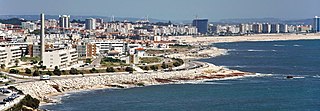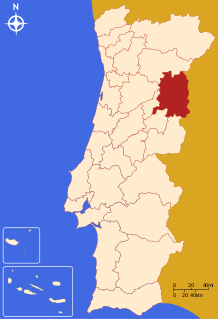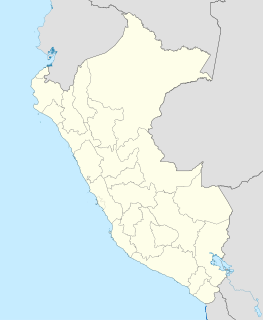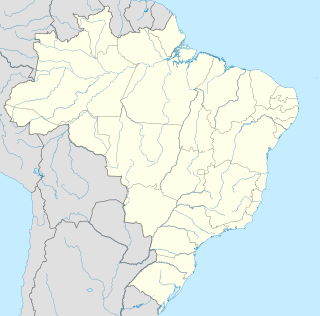Related Research Articles

Figueira da Foz, also known as Figueira for short, is a city and a municipality in the Coimbra District, in Portugal. Practically at the midpoint of the Iberian Peninsula's Atlantic coast, it is located at the mouth of the Mondego River, 40 km (25 mi) west of Coimbra and sheltered by hills, sharing about the same latitude with Philadelphia, Baku and Beijing. The population in 2011 was 62,125, in an area of 379.05 km2 (146.35 sq mi). The city of Figueira da Foz proper has a population of 46,600. It is the second largest city in the district of Coimbra.

The district of Guarda is located in the Centro Region of Portugal, except Vila Nova de Foz Côa, which is in the Norte Region. The district capital and most populous city is Guarda.
Pantanal Linhas Aéreas S.A. was a regional airline based in São Paulo, Brazil and incorporated by TAM Airlines in 2013. It served destinations mainly in the southeast region of Brazil from its bases at Congonhas and Guarulhos airports in São Paulo.

The Central Region or Central Portugal is one of the statistical regions of Portugal. The cities with major administrative status inside this region are Coimbra, Aveiro, Viseu, Caldas da Rainha, Leiria, Castelo Branco, Covilhã, Torres Vedras and Guarda. It is one of the seven Regions of Portugal. It is also one of the regions of Europe, as given by the European Union for statistical and geographical purposes. Its area totals 28,462 km2 (10,989 sq mi). As of 2011, its population totalled 2,327,026 inhabitants, with a population density of 82 inhabitants per square kilometre.

Beira Interior Norte is a former Portuguese subregion in the Centro Region. It was abolished at the January 2015 NUTS 3 revision. It was also part of an urban community (ComUrb) called Beiras. The capital and most important city was Guarda. Other towns with Portuguese city status (cidade) included: Pinhel (3,500), Sabugal (3,200), Trancoso (3,000) and Mêda (2,004).

Figueira de Castelo Rodrigo is a municipality in the District of Guarda in Portugal. The population in 2011 was 6,260, in an area of 508.57 km². Located in the Riba Coa, just like other municipalities around Riba Coa, such as Almeida, Meda, Pinhel and Sabugal. Known for its castle which is a listed National monument, as well as pine-wood forests and rolling hills.

Mayor General FAP Armando Revoredo Iglesias Airport, known in Spanish as Aeropuerto Mayor General FAP Armando Revoredo Iglesias, is an airport serving Cajamarca, capital of the Cajamarca Region in Peru. It is run by CORPAC S.A., a government organization that oversees management of Peruvian airports.

Hugo Miguel Pereira de Almeida is a Portuguese former professional footballer who played as a centre forward.

The Praça da Figueira is a large square in the centre of Lisbon, in Portugal. It is part of the Lisbon Baixa, the area of the city reurbanised after the 1755 Lisbon earthquake.
Octávio Figueira Trompowsky de Almeida was a Brazilian chess player, who was born and died in Rio de Janeiro. Trompowsky won the 1939 Brazilian Championship, but is best known as the player for whom the Trompowsky Attack chess opening was named.

Os Mutantes: Caminhos do Coração is a Brazilian telenovela which originally aired on Rede Record.
Marshal is the highest rank in both the Brazilian Army and the Brazilian Air Force, although the latter is titled marechal-do-ar. These ranks are equivalent to that of admiral in the navy. A marshal is distinguished by using five stars, which for a marshal of the air are in the approximate position of Southern Cross and for a marshal in the army, in the form of "X". The five stars of admiral are in the shape of a pentagon.

João Armando Pereira Gonçalves, ComIH of Figueira da Foz, Portugal is the former chairperson of the World Scout Committee, the main executive body of the World Organization of the Scout Movement. He was a member of the European Scout Committee for a period of six years, elected in 2004 and again in 2007, and was elected to the World Scout Committee at the 39th World Scout Conference in Brazil in January 2011. He was re-elected to the committee at the 40th World Scout Conference in Ljubljana, Slovenia in 2014.

Major-Brigadeiro Trompowsky Airport is the airport serving Varginha, Brazil. The airport is named after Armando Figueira Trompowsky de Almeida (1889-1964) former Minister of the Brazilian Air Force.

The following is a list of the orders, decorations, and medals of Brazil:

The Politburo of the Central Committee of the Communist Party of Cuba is the party's highest decision-making body in between sessions of the Central Committee. The party's First Secretary chairs the body's meetings.

Alférez Armando Rodríguez Airport is a public use airport serving Las Lomitas, a town in the Formosa Province of Argentina. The airport is 3 kilometres (2 mi) east of the town.
Napomuceno's Will theatrically as O Testamento do Senhor Napumoceno, is a 1997 Cape Verdean drama film directed by Francisco Manso and co-produced by director himself with António Gonçalo. The film is based on the novel The Last Will and Testament of Senhor da Silva Araújo wrote by Germano Almeida.
A Sinhalese name or Sinhala name may contain two or three parts: a patronymic, one or more given names, and sometimes a surname, which was often absent in the past. Full names can be rather long, and hence are often shortened, by omitting or abbreviating the family name and one of the given names, as in R. M. S. Ariyaratna.